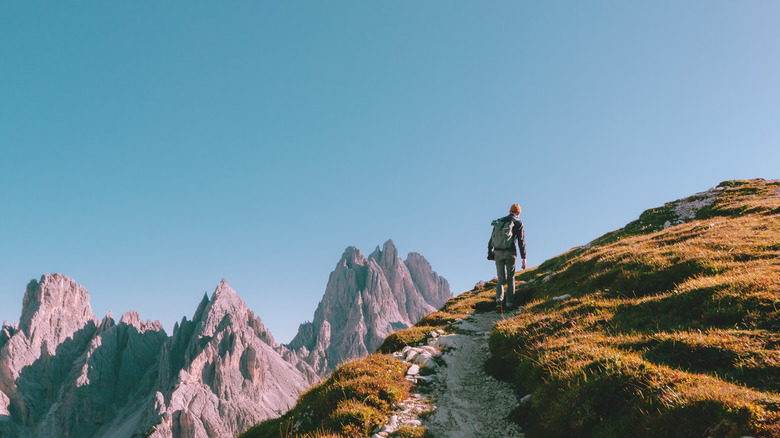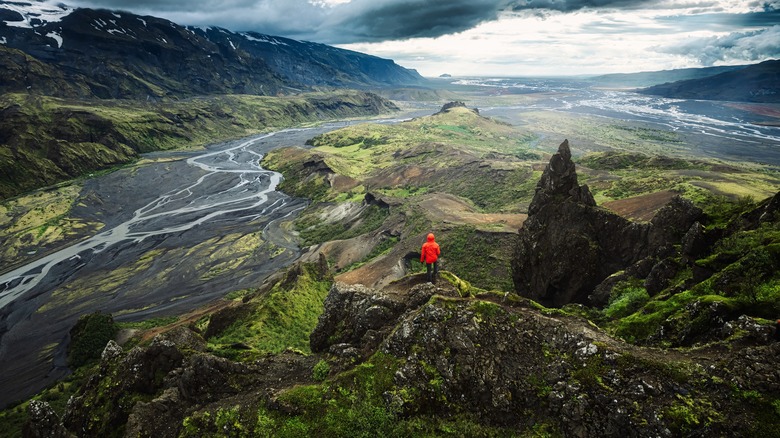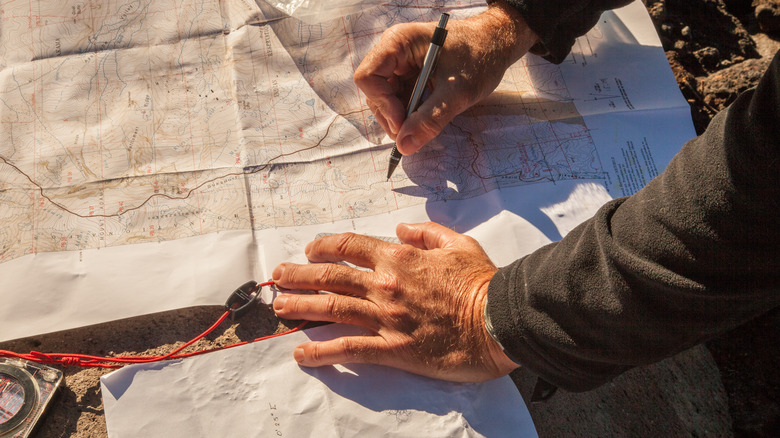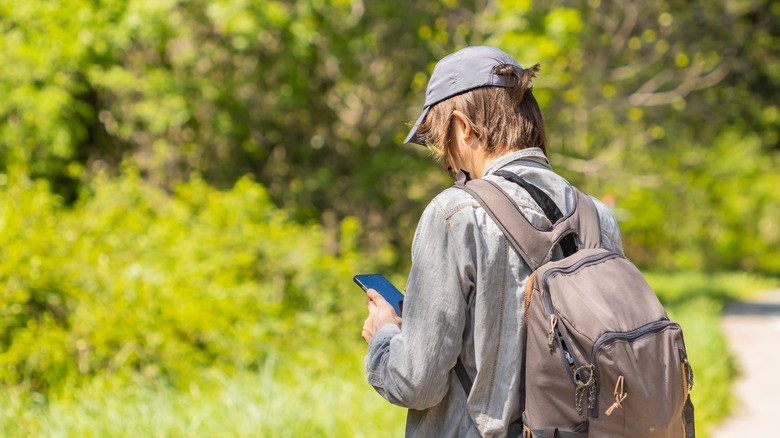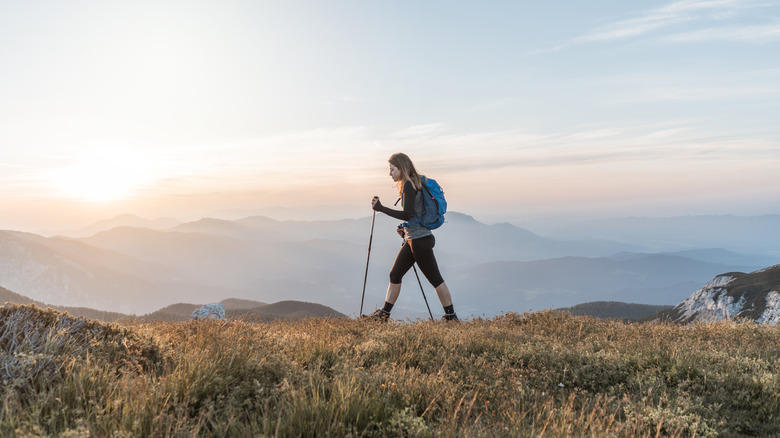Safety Tips To Know Before Your First Solo Hike
Going for a solo hike can be a fantastic way to connect with nature while reconnecting with yourself. For many, the idea of being alone in the wilderness is an exciting one, but the fear of something going wrong keeps some from hitting the trail alone. Those fears are entirely justified — it is more dangerous to hike by yourself. When you're alone, taking a wrong turn or sustaining a mild injury is a much bigger concern than if you were hiking with a group. However, if you take proper precautions, your first solo hike can be a fun and safe experience.
Depending on the route you choose, hiking can be physically exhausting, and the last thing you want to do is find out you're at your limit halfway through a solo trek up a mountain. Whether you're hiking in Waikiki or Wyoming, you should always thoroughly research any path you plan to take beforehand so you're familiar with the twists and turns of the trail ahead of time. If you can choose a route you've hiked before, that's even better, as you're less likely to get lost or find out you aren't physically up for the challenge. As exhilarating as it can be to push yourself to the limit, save those more arduous journeys for when you have built up a bit of solo hiking experience.
Consider trail conditions
One of the things that makes going out into nature alone such a thrilling experience is that no two trips are ever exactly alike. However, failing to consider the trail's changing conditions is one of the worst mistakes you can make while hiking alone. To stay safe, plan ahead and be aware of what it's likely to be like on your route before you set out. Always check the weather before you start, and stay alert to changes as you go. Dressing appropriately and choosing the right footwear and gear for the potential conditions can make the difference between a great trip and a disaster.
Don't be afraid to change your plans. If the weather looks poor the morning of your trip, or even if you've already started your hike and notice the weather is getting bad, redirecting to an easier hike or even turning around and heading home is the right thing to do. As disappointing as rescheduling your trip is, staying on schedule isn't worth risking your life. Muddy trails can slow you down or make a usually safe area slippery. Storms and flash floods can be deadly. One of the best ways to determine if it's safe to hit the trails is to stop by a park visitor center and ask a ranger – but trust your instincts, too. If you feel it's unsafe, don't take the risk.
Make sure others know where you're going
While one of the goals of a solo hike is to get out into nature by yourself, that doesn't mean you should be completely isolated in your journey. While nobody else is coming with you on the trail, another person should always know where you are and when you're coming back. If something goes wrong while you're hiking alone, you want to be sure that rescuers can find you.
It's fun to imagine just walking out into the wilderness solo, but in reality, that's not a good practice. Plan your route thoroughly in advance, write it down, and leave it with a trusted friend. Plan to check in at specific times and let them know when you should be back. If you don't return as planned, they should be prepared to contact emergency services. If you can't find someone to be on call for you during your hike, you can always leave your plans with a park ranger at the visitor center so that they know where to look for you if you don't come back on time.
Don't depend on your phone
Most of us use the internet for everything in our day-to-day lives. From YouTube videos of others doing the hike before you to minute-by-minute weather updates for your area, your phone can be a vital resource when planning your first solo hike. However, once you're on the trail, expecting to use your phone for anything essential is a big mistake. In many wild places, there is limited or no cell service, so if you plan to use your phone to call for help in an emergency or the GPS to navigate your way home, you could be in big trouble.
Rather than expecting to use your phone to find your way, try your best to learn all about the trail in advance so that you're less likely to get lost, and consider learning to use a physical map and a compass to point yourself in the right direction. You can even get a GPS unit specifically designed for hiking, which is more likely to have reception. Some can even send a message to your emergency contact via satellite.
Avoid bugs and bears
One of the most important things to read up on in advance is what kind of wildlife you may encounter on the trail. From the tiniest bugs to the biggest bears, you don't want to be caught unprepared when dealing with beasts on your solo hike. Depending on the season, you may encounter a lot of bugs. That's to be expected when you're out in nature, but there are some bugs you'll want to avoid as best you can, like mosquitos and ticks. If you're worried about bug bites, minimize how much skin these bloodsuckers can snack on. If you're hiking in an area where bugs carry diseases, you should consider using bug spray.
While you won't spray this one all over yourself as a deterrent, you may also want to consider carrying bear spray. Hiking in bear territory is generally safe, but there are some precautions you should take — especially if you're alone. If a bear encounter is possible, traveling in a group is generally much safer. If you must solo hike in bear country, make plenty of noise as if you were in a group. Talk out loud to yourself and move slowly through the woods so you don't surprise the animals. You should also schedule your hike for the afternoon and be back before dusk when the bears are more active.
Pack enough supplies for emergencies
When you're traveling in an experienced group, you can rely on others to pack anything you happen to forget, but when you're hiking alone, there is no safety net. Finding the right balance between being overburdened with too much gear and not having enough supplies to get through your hike safely is vital. As annoying as it may be to carry them, you should never skip out on the essentials like weather-protective clothing and a first aid kit.
Water is probably the most important thing you can bring with you. Remember that you may need more than you think — both because you'll get thirstier while exercising and you never know when unexpected delays may occur, forcing you to be alone in the wilderness for longer than you planned. The same goes for food. If you're going to be hiking in an area where there's a risk you won't get back before dark, you should always make sure you have a flashlight and, in some situations, basic equipment for a solo camping trip, in case you're forced to stay the night.
